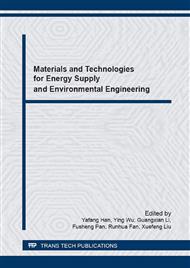[1]
F. Andreola, L. Barbieri, A. Corradi, I. Lancellotti, Cathode ray tube glass recycling: an example of clean technology, Waste Manag. Res. 23(2005) 314–321.
DOI: 10.1177/0734242x05054422
Google Scholar
[2]
F. Andreola, L. Barbieri, A. Corradi, I. Lancellotti, R. Falcone, S. Hreglich, Glass-ceramics obtained by the recycling of end of life cathode ray tubes glasses, Waste Manag. Res. 25(2005)183–189.
DOI: 10.1016/j.wasman.2004.12.007
Google Scholar
[3]
N. Menad, Cathode ray tube recycling, Resour. Conserv. Recycl. 26(1999) 143-154.
Google Scholar
[4]
V. Palm, Environmental hazards connected to the composition of cathode-ray tubes and cabinets, Swedish Environmental Research Institute, Stockholm, (1995).
Google Scholar
[5]
C.H. Lee, C.S. His, Recycling of scrap cathode ray tubes. Environment Sci. Tech. 36(2002) 69–75.
Google Scholar
[6]
E. Jefferies, E-wasted Toys and gadgets become toxic junk thanks to the circuitbored,. Worldwatch. 9(2006) 21-25.
Google Scholar
[7]
J.R. Mueller, M.W. Boehm, C. Drummond. Direction of CRT waste glass processing: electronics recycling industry communication, Waste Manag. Res. 32(2012)1560-1565.
DOI: 10.1016/j.wasman.2012.03.004
Google Scholar
[8]
Q.A. Ogunseitan, J.M. Schoenung, J. Saphores, A. Shapiro. The electronics revolution: from e-wonderland to e-wasteland. Science 2009. 326(2009) 670-671.
DOI: 10.1126/science.1176929
Google Scholar
[9]
R.G. Pike, D. Hubbard, Physicochemical studies of the destructive alkali-aggregate reaction in concrete, Journal of Research of the National Bureau of Standards. 59(1957) 127–132.
DOI: 10.6028/jres.059.013
Google Scholar
[10]
R.G. Pike, D. Hubbard, E.S. Newman, Binary silicate glasses in the study of alkali-aggregate reaction, Highway Research Board. 275(1960) 39–44.
Google Scholar
[11]
A. Scmidt, W.H.F. Saia, Alkali-aggregate reaction tests on glass used for exposed aggregate wall panel work, Aci. Mater. J. 60 (1963) 1235–1236.
Google Scholar
[12]
J.C. Phillips, D.S. Cahn, G.W. Keller, Refuse glass aggregate in Portland cement, Proceeding of the 5th Mineral Waste Utilization Symposium, Chicago Research Institute, 1972, p.385–390.
Google Scholar
[13]
C.D. Johnston, Waste glass as coarse aggregate for concrete, J. Test. Eval. 2(1974) 34450.
Google Scholar
[14]
V. Corinaldesi, G. Gnappi, G. Moriconi, A. Montenero, Reuse of ground waste glass as aggregate for mortars. Waste Manag. Res. 25(2005) 197-201.
DOI: 10.1016/j.wasman.2004.12.009
Google Scholar
[15]
G. Kuruppu, R. Chandratilake, Use of recycle glass as a coarse aggregate in concrete, World Construction Conference 2012 – Global Challenges in Construction Industry. 28-30(2012) 221-228.
Google Scholar
[16]
T.C. Ling, C.S. Poon, Feasible use of recycled CRT funnel glass as heavyweight fine aggregate in barite concrete, J. Clean. Pro. 33(2012) 42-49.
DOI: 10.1016/j.jclepro.2012.05.003
Google Scholar
[17]
G. Lee, T.C. Ling, Y.L. Wong, C.S. Poon, Effects of crushed glass cullet sizes, casting methods and pozzolanic materials on ASR of concrete blocks. Constr. Build. Mater. 25(2011) 2611-2618.
DOI: 10.1016/j.conbuildmat.2010.12.008
Google Scholar
[18]
S.C. Kou, C.S. Poon, Properties of self-compacting concrete prepared with recycled glass aggregate. Cement. Concrete. Comp. 31(2009) 107-113.
DOI: 10.1016/j.cemconcomp.2008.12.002
Google Scholar
[19]
A. Shayan, A. Xu, Value-added utilization of waste glass in concrete. Cem. Concr. Res. 34(2004) 81–89.
Google Scholar
[20]
C. Shi, Y. Wu, C. Riefler, H. Wang, Characteristics and pozzolanic reactivity of glass powders, Cem. Concr. Res. 35(2005) 987–993.
Google Scholar


